Singapore’s Rain Power Revolution: Harnessing Electricity from Every Drop 🌧⚡
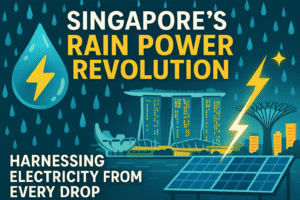
Rain falls almost everywhere on Earth, and until now, it’s been an untapped source of energy. But scientists in Singapore have unveiled an innovative system that turns ordinary raindrops into electricity—without the need for large rivers or dams. This groundbreaking technology is paving the way for clean, renewable energy from one of nature’s most abundant resources.
A team from the National University of Singapore has developed a method that allows people to harvest electricity directly from falling rainwater. Through an ingenious process, rain has been transformed into a viable energy source.
When we think about renewable energy, we often picture massive wind turbines or sprawling solar farms. Hydropower typically relies on large dams and flowing rivers. While effective, these energy sources require specific conditions—strong winds, abundant sunshine, or vast bodies of water. But rain offers something different: it falls everywhere, from cities to remote areas, making it an accessible energy source for many regions across the globe.
Creating Electricity with ‘Plug Flow’
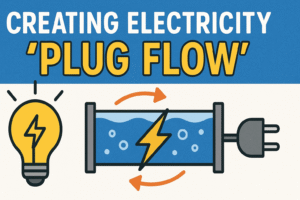
The magic of this rain-powered system lies in a concept called “plug flow.” The technology works by using water flowing through specially designed tubes to generate electrical charges. In this setup, a metallic needle allows raindrops to drip into a conductive tube. When the drops hit the tube, they break into pieces with air gaps between them, forming a unique flow pattern.
As the water columns move through the narrow 12-inch tube, the droplets are separated by air pockets, which naturally generate electrical charges. Wires attached to both ends of the tube capture these charges, creating usable electricity.
In lab tests, researchers discovered that water droplets gain or lose charges when they pass over certain surfaces, similar to the static electricity created by rubbing a balloon on your hair. The team found ways to maximize and capture these charges, making the process highly efficient.
Earlier methods of harvesting energy from water were limited due to the small areas in which they could generate power. However, the plug-flow approach developed by Singapore’s team has overcome this challenge. The tubes are made from electrically conductive polymers, special plastics that carry current. Each raindrop impacting the tube helps create ideal conditions for electricity generation.
Proof It Works: Lighting Up LEDs with Raindrops
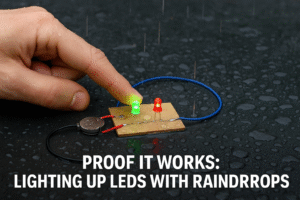
The lab tests were a huge success. The system was able to convert over 10 percent of the energy from falling raindrops into usable electricity. The plug-flow method performed five times better than tests using steady water streams. In some tests, a single setup powered multiple LED lights, and when two tubes were used, the electrical output doubled. These tests used droplet speeds much slower than actual rainfall, meaning the technology could perform even better in real-world conditions.
One of the most impressive tests demonstrated that enough power was generated to keep 12 LED lights lit for 20 seconds continuously. While this isn’t yet comparable to the massive output of power plants, the results are promising and suggest that the technology could scale up for larger applications.
How Rain Power Compares to Traditional Hydropower
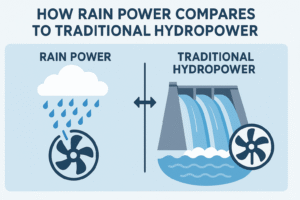
Traditional hydropower depends on large dams, which are costly to build and require specific geographic conditions, such as fast-flowing rivers or large water bodies. These dams can disrupt ecosystems, and their effectiveness is limited to certain areas.
In contrast, rain-powered systems offer a revolutionary alternative. They are lightweight, require minimal materials, and can be installed in any area that receives sufficient rainfall. This makes them remarkably versatile and especially well-suited for urban environments, where space is limited. Moreover, these systems can be installed without disturbing surrounding communities, making them a sustainable and low-impact solution.
Recent tests have confirmed that rain energy systems can convert over 10 percent of the energy from raindrops into usable electricity. Optimistic reports suggest that fully developed rain-harvesting systems could be ten times more efficient than traditional hydropower when considering space efficiency and accessibility.
Could Your Roof Become a Mini Power Station?
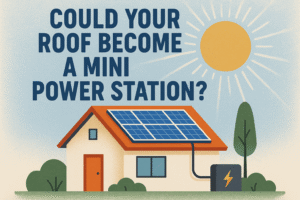
One of the most exciting applications of this technology is the potential for rooftop installations. Urban rooftops, often large and underutilized, are perfect for capturing energy from rainfall. In cities with abundant rainfall, rooftops could generate power locally, reducing reliance on centralized energy plants.
Siowling Soh, the lead author of the research published in ACS Central Science, explains, “Water that falls through a vertical tube generates a substantial amount of electricity using a specific flow pattern called plug flow. This pattern could allow rain energy to be harvested for clean, renewable electricity.”
With millions of rooftops available across cities, these systems could become a valuable energy source. Though they may not initially replace other power sources, such as solar, rain power can supplement existing systems, creating a more diverse and resilient energy mix.
What’s Next for Rain Power?
As the technology continues to evolve, researchers are exploring ways to scale up these systems. Using more tubes in arrays or panels could drastically increase the total electricity generated. Future designs might also integrate rain power with other renewable energy sources, such as solar panels. Combining these technologies would ensure a more consistent power supply, even during cloudy or rainy days.
Singapore is at the forefront of this green energy revolution, and the government’s support for such innovations reflects a growing commitment to environmental sustainability. As these rain-harvesting systems are refined and scaled, they could significantly contribute to a cleaner, greener energy future.
-
National University of Singapore’s Research on Rain Power
Link to NUS -
Renewable Energy Research
Link to Renewable Energy World -
Overview of Hydropower and Its Environmental Impact
Link to International Hydropower Association -
Rain Power as an Emerging Renewable Source
Link to Nature Energy Journal
Conclusion: A Simple Drop, A Big Impact
Ordinary rainfall, which many of us see as nothing more than an inconvenience, could soon become a valuable energy resource. Just as wind power harnesses the force of the wind and solar power taps into sunlight, rain power takes advantage of a natural resource that’s abundant, consistent, and often overlooked.
With ongoing advancements, researchers are turning every raindrop into potential energy, offering a glimpse into a future where rain itself powers our homes, cities, and communities.

